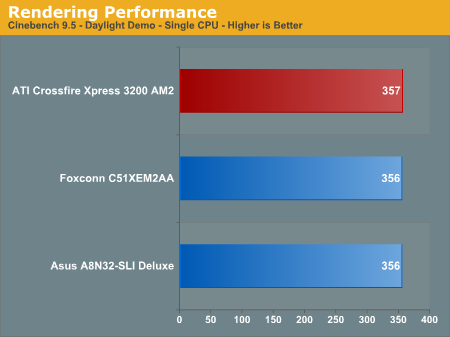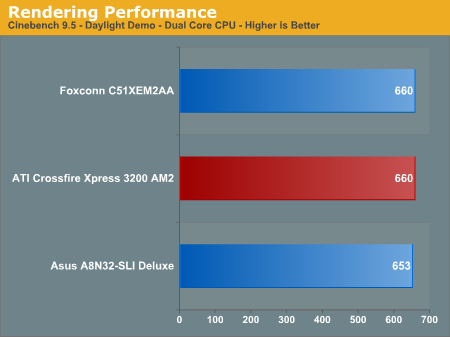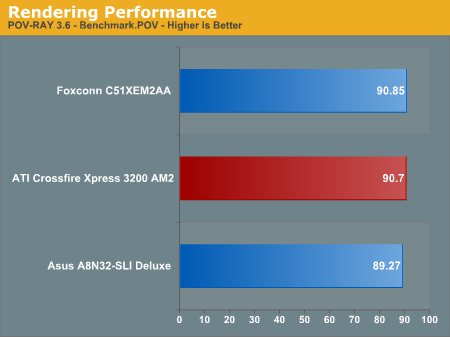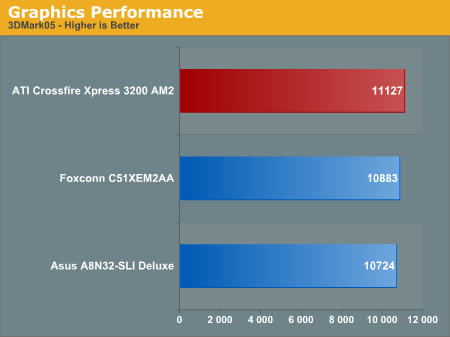CrossFire Xpress 3200: RD580 for AM2
by Wesley Fink on June 1, 2006 12:05 AM EST- Posted in
- Motherboards
General Performance
With the Memory Controller on the Athlon 64 Processor, Winstone benchmarks are no longer very revealing of motherboard performance. With the same CPU (and the same memory controller on that CPU) Winstones, both Business and Multimedia Content Creation, are tightly clustered. The only deviation from that is that boards that are tweaked for best gaming performance are often near the bottom of a tight range of benchmark performance numbers. The Winstone tests themselves are rapidly becoming dated, and are no longer supported by PC Magazine. While Winstones are still useful in providing real world performance data we are dropping Winstones from our standard motherboard test suite.

PCMark 2005 results with the ATI AM2 show the CrossFire Xpress 3200 AM2 with a 40 point lead. The nForce 590 and ATI AM2 should be considered equivalent in performance. Both show a 200+ point lead over the DDR-based Asus A8N32-SLI, consistent across both AM2 platforms.
Despite the close results in these tests, PCMark05 is proving to be a useful overall performance benchmark. It is generally more sensitive than the older Winstones and PCM04 to recent improvements in PC architecture. PCMark 05 results in general relate well to the other performance results we find in our board tests - providing a quick and reliable snapshot of board performance compared to other motherboards.



We have replaced Winstones with 2 benchmarks that use rendering to test system performance. Cinebench 9.5 and POV-RAY 3.6 benchmarks both heavily stress the CPU subsystem while performing graphics modeling and rendering. We utilize the standard benchmark demos in each program along with the default settings. Cinebench 9.5 features two different benchmarks with one test utilizing a single core and the second test showcasing the power of multiple cores in rendering the benchmark image.
Single-Core and POV-Ray results are extremely close across DDR and DDR2 platforms. However, Dual-Core Cinebench results show both NVIDIA and ATI AM2 chipsets with a larger lead over the DDR platform. Since all 3 systems were tested with a dual-core CPU at the same speed, this provides a bit of evidence that dual-core (and quad core potentially) can make better use of the extra DDR2 memory bandwidth.
3D Graphics
The 3DMark benchmarks, published by Futuremark, are probably the most widely quoted gaming performance benchmarks available. While the benchmarks are based on game sequences written by Futuremark to reveal subtle differences in gaming performance, they still have to be considered synthetic benchmarks. They are useful for broad graphics comparisons, but they are no substitute for benchmarks with real gaming engines that are currently being played.
SLI and CrossFire are also generally supported in 3DMark, but we ran 3DMark2005 and 2006 in standard mode only as we are not comparing SLI and CrossFire in this chipset review. Please take a closer look at CrossFire benchmarks later in this review for comparisons of CrossFire and SLI performance in several current games. 3DMark06 was recently introduced and you can find more in-depth information about this new 3DMark in the AnandTech article Futuremark's Latest Attempt: 3DMark06 Tested.


The 05 and 06 results both show the ATI AM2 in the lead, but the margin is small enough to be within the margin of error. Again, both AM2 boards outperform the DDR platform by several hundred points. The ATI and NVIDIA AM2 boards can be considered a dead heat in 3D Graphics performance.
Encoding
We have found encoding results are not affected by the graphics card used during the encoding benchmarks. This is demonstrated again and again by archive test results for AutoGK using an AMD 4000+ processor with a wide assortment of video cards. The performance range of those encoding tests is just 48.1 to 49.1 - a difference form high to low of just 1.0 frame. Clearly the biggest influence on this encoding benchmark is the CPU used for testing. Because encoding test results vary so little on the same standardized motherboard test platform, they have been dropped from this review and future reviews. Encoding tests are very useful in CPU testing, but they have been shown to be poor motherboard tests - particularly on the AMD platform with the memory controller on the CPU.
With the Memory Controller on the Athlon 64 Processor, Winstone benchmarks are no longer very revealing of motherboard performance. With the same CPU (and the same memory controller on that CPU) Winstones, both Business and Multimedia Content Creation, are tightly clustered. The only deviation from that is that boards that are tweaked for best gaming performance are often near the bottom of a tight range of benchmark performance numbers. The Winstone tests themselves are rapidly becoming dated, and are no longer supported by PC Magazine. While Winstones are still useful in providing real world performance data we are dropping Winstones from our standard motherboard test suite.

PCMark 2005 results with the ATI AM2 show the CrossFire Xpress 3200 AM2 with a 40 point lead. The nForce 590 and ATI AM2 should be considered equivalent in performance. Both show a 200+ point lead over the DDR-based Asus A8N32-SLI, consistent across both AM2 platforms.
Despite the close results in these tests, PCMark05 is proving to be a useful overall performance benchmark. It is generally more sensitive than the older Winstones and PCM04 to recent improvements in PC architecture. PCMark 05 results in general relate well to the other performance results we find in our board tests - providing a quick and reliable snapshot of board performance compared to other motherboards.



We have replaced Winstones with 2 benchmarks that use rendering to test system performance. Cinebench 9.5 and POV-RAY 3.6 benchmarks both heavily stress the CPU subsystem while performing graphics modeling and rendering. We utilize the standard benchmark demos in each program along with the default settings. Cinebench 9.5 features two different benchmarks with one test utilizing a single core and the second test showcasing the power of multiple cores in rendering the benchmark image.
Single-Core and POV-Ray results are extremely close across DDR and DDR2 platforms. However, Dual-Core Cinebench results show both NVIDIA and ATI AM2 chipsets with a larger lead over the DDR platform. Since all 3 systems were tested with a dual-core CPU at the same speed, this provides a bit of evidence that dual-core (and quad core potentially) can make better use of the extra DDR2 memory bandwidth.
3D Graphics
The 3DMark benchmarks, published by Futuremark, are probably the most widely quoted gaming performance benchmarks available. While the benchmarks are based on game sequences written by Futuremark to reveal subtle differences in gaming performance, they still have to be considered synthetic benchmarks. They are useful for broad graphics comparisons, but they are no substitute for benchmarks with real gaming engines that are currently being played.
SLI and CrossFire are also generally supported in 3DMark, but we ran 3DMark2005 and 2006 in standard mode only as we are not comparing SLI and CrossFire in this chipset review. Please take a closer look at CrossFire benchmarks later in this review for comparisons of CrossFire and SLI performance in several current games. 3DMark06 was recently introduced and you can find more in-depth information about this new 3DMark in the AnandTech article Futuremark's Latest Attempt: 3DMark06 Tested.


The 05 and 06 results both show the ATI AM2 in the lead, but the margin is small enough to be within the margin of error. Again, both AM2 boards outperform the DDR platform by several hundred points. The ATI and NVIDIA AM2 boards can be considered a dead heat in 3D Graphics performance.
Encoding
We have found encoding results are not affected by the graphics card used during the encoding benchmarks. This is demonstrated again and again by archive test results for AutoGK using an AMD 4000+ processor with a wide assortment of video cards. The performance range of those encoding tests is just 48.1 to 49.1 - a difference form high to low of just 1.0 frame. Clearly the biggest influence on this encoding benchmark is the CPU used for testing. Because encoding test results vary so little on the same standardized motherboard test platform, they have been dropped from this review and future reviews. Encoding tests are very useful in CPU testing, but they have been shown to be poor motherboard tests - particularly on the AMD platform with the memory controller on the CPU.










71 Comments
View All Comments
JarredWalton - Thursday, June 1, 2006 - link
And you thought LinkBoost was fast! ;)Typo fixed, thanks.
Stele - Thursday, June 1, 2006 - link
A main attraction of HD audio over AC'97 other than 100.1 setups is probably better sound quality. As such, perhaps Anandtech needs to develop a test method and/or utility with which to assess precisely this aspect of motherboards' sound subsystems. Low CPU utilisation is well and good but ultimately it's reaching the point where these figures are fairly meaningless, as this review underscored.Instead, besides just testing CPU utilisation, Anandtech could test/measure characteristics such as SNR ratio, THD at a reference frequency etc. at the output ports. The test can then be rounded off with subjective hearing tests through reference speakers or headphones, e.g. for irritating crossover noise from the mouse (A7N8X anyone?) or some other EMI source, and so on.
That way, we can judge if a motherboard manufacturer's implementation and motherboard design are sound (pun intended) because ultimately, it's about what you hear, not see; an 8.1 with terrific speakers, built in DTS/AC3/etc and other paper-spec niceties isn't going to cut it if the codec was, say, jammed right next to the CPU PWM controller with barely any grounding.
Gary Key - Thursday, June 1, 2006 - link
We are still debating our "subjective" results and comments for the audio section. However, at some point this summer we will expand our testing to include additional testing outside the CPU utilization and game results.
Stele - Friday, June 2, 2006 - link
Subjective is, understandably, subjective. Thus such results are bound to differ depending on the person assessing the product as well as the circumstances under which the test was done. IMHO, it should therefore only play a small part in the extended test, complementing the objective, measured figures which should play the dominant role in an extended audio test.Indeed, accurately measuring such performance characteristics (SNR, THD, no-signal background noise level) would probably be more useful because even if the subjective part of the test is completely left out, the figures would generally be a sufficient gauge of the quality of the components and implementation (circuit design, manufacture etc).
Having said that, the subjective opinions do give the review a human perspective and a broader picture which numbers alone may not fully convey - another good example being noise level measurements. Again, nice to have but won't be fatal without it.
Just my 2 cents' :)
Beenthere - Thursday, June 1, 2006 - link
...and you can be certain that production mobos will NOT perform as well as the reference mobo. Expect Asus to use a hack design, DFI to have a pretty good design less proper ports, Sapphire to not have a clue at copying the ATI reference mobo, Abit to talk shitza but not deliver, etc. and the prices will be sky high. Ya gotta wonder how much longer people are going to buy crap mobos just because they have a good chipset?Stele - Thursday, June 1, 2006 - link
Perhaps it's because there're aren't many seriously viable choices - if any - other than the 'crap mobo' brands you listed? The manufacturers know this too, and rest in the relative comfort of the knowledge that since no brand's perfect, buyers aren't likely to suddenly all jump ship in a hurry. They're probably expecting people to grumble and complain, as always, but buy from one of them anyway... as always.xsilver - Thursday, June 1, 2006 - link
Does ATI have license to product intel chipsets either now or in the future?or was their some exclusivity when nvidia made their cross licensing agreement?
Gary Key - Thursday, June 1, 2006 - link
ATI has been producing Intel compatible chipsets for a few years now and we should see a "RD580" type chipset for Conroe later this summer.
fzkl - Thursday, June 1, 2006 - link
Why are the setups using different hard drives? The ATI system has a 16MB buffer whereas the Nvidia system has an 8 MB buffer. Does that contribute to any performance difference?peternelson - Thursday, June 1, 2006 - link
I spotted that too. I imagine the HD might change the PCMark result.